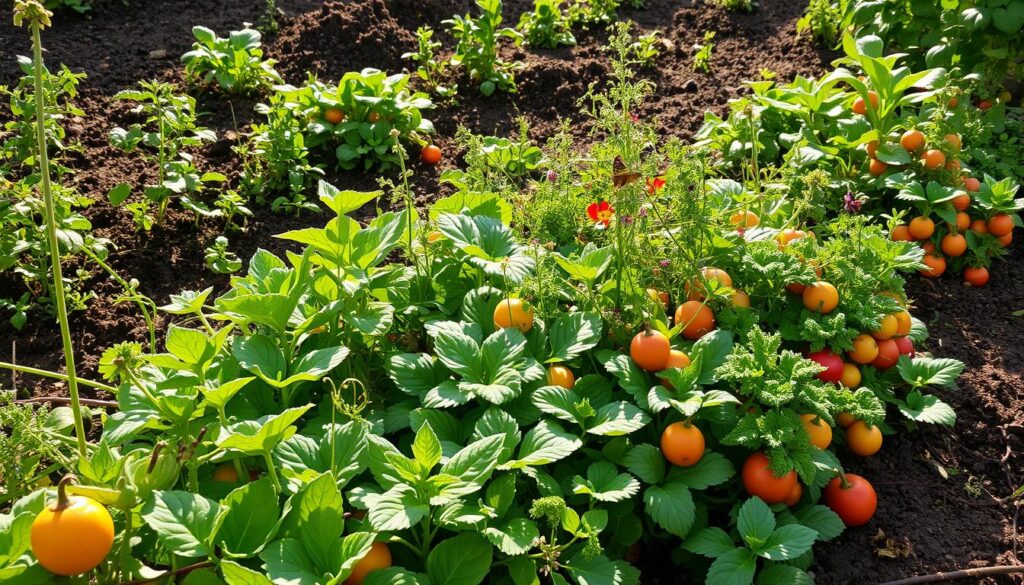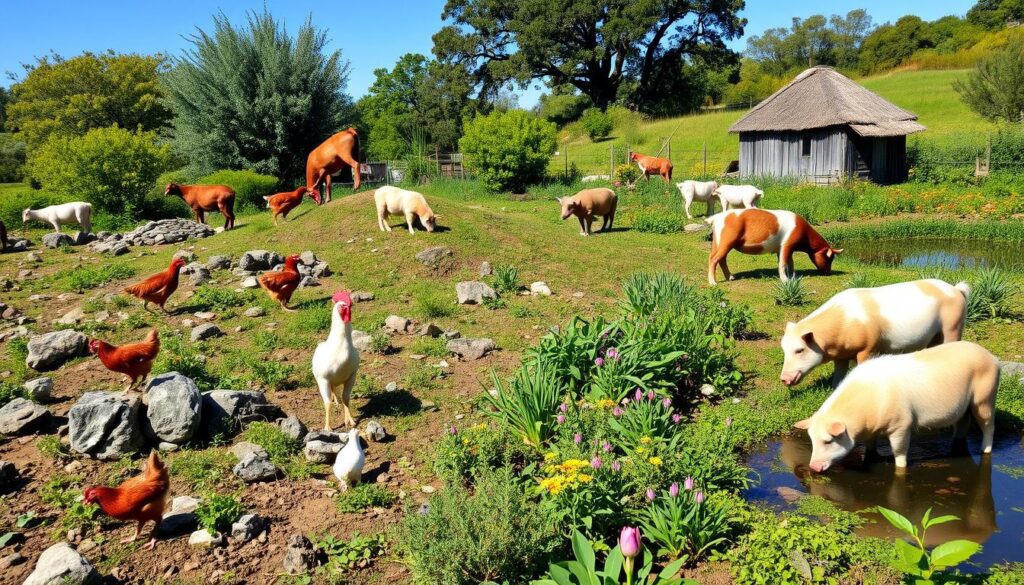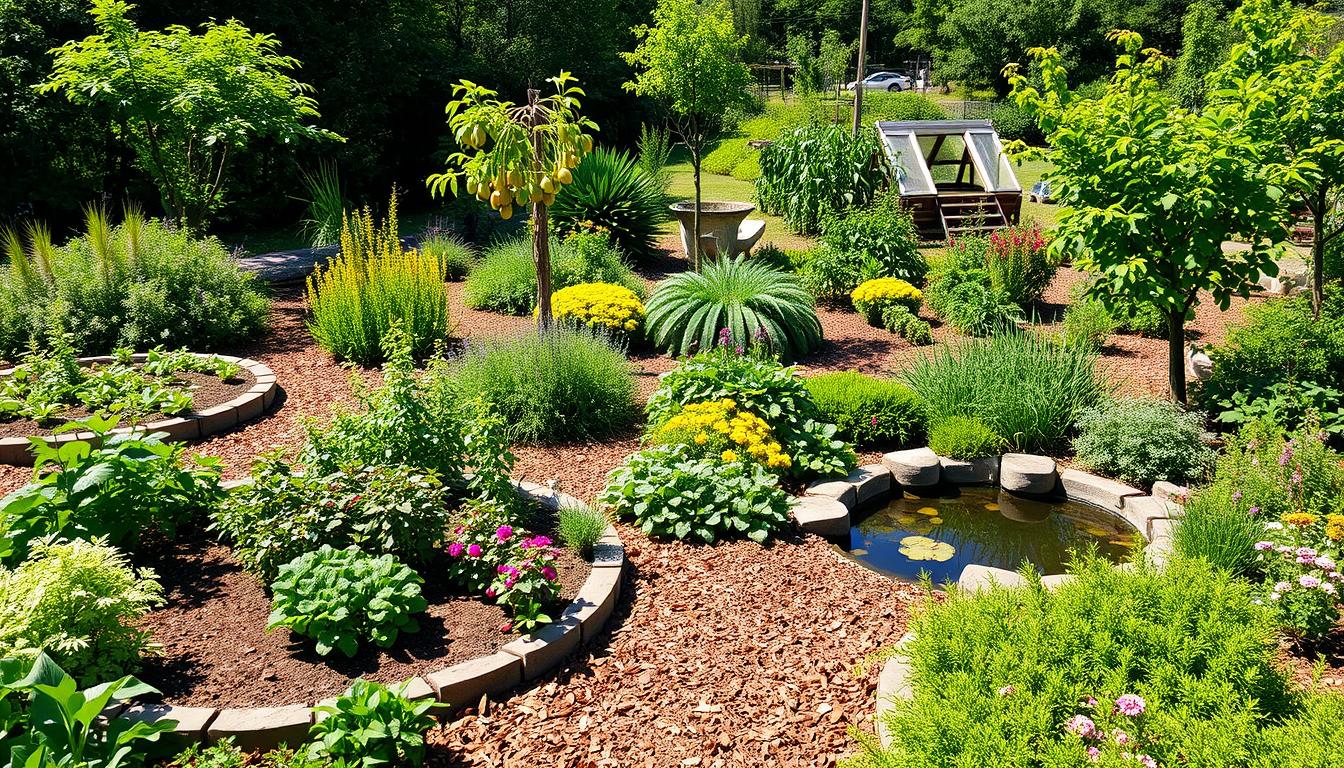Looking out at my backyard garden, I felt a deep connection and gratitude. It was more than a garden; it was a living ecosystem. It gave us food and showed us how to live in harmony with nature. This is what permaculture is all about.
This guide is for anyone interested in sustainable living. We’ll explore how to design your garden, farm naturally, and build eco-friendly homes. You’ll learn how to live a self-sufficient and environmentally-conscious life.
Permaculture is not just gardening. It’s a way to design our living spaces like nature. You’ll learn to use biodiversity, improve soil, and manage water. It helps us face environmental challenges together.
Key Takeaways
- Discover the fundamental principles of permaculture and how to apply them to your lifestyle
- Learn proven techniques for designing and maintaining a thriving permaculture garden
- Explore the benefits of sustainable living, including regenerative agriculture and eco-friendly building
- Understand the importance of biodiversity conservation and creating community resilience
- Gain the knowledge and strategies to cultivate a self-sufficient, eco-conscious way of life
What is Permaculture?
Permaculture is a way to design sustainable living and farming by copying nature. It focuses on permaculture principles to help all life forms. This approach aims to create harmony in our environment.
Defining Permaculture Principles
The key principles of permaculture are about working with nature. They include observing, interacting, and using energy wisely. These steps help create systems that are good for the planet and all living things.
History and Origins of Permaculture
In the 1970s, Australians Bill Mollison and David Holmgren started permaculture. They were inspired by old farming ways and wanted a better way to live. They believed in working with nature to solve big problems.
“Permaculture serves as a valuable skill applicable across various areas of life, instilling intrinsic motivation to combat climate change.”
Benefits of a Permaculture Lifestyle
Living a permaculture lifestyle has many benefits for both people and the planet. It involves designing systems that work like nature. This leads to sustainable living by using less resources, making less waste, and being self-sufficient.
Permaculture also promotes regenerative agriculture. This means improving soil health, boosting biodiversity, and growing food that’s full of nutrients. All of this is done without using harmful chemicals.
Sustainable Living
Permaculture is all about living sustainably. Homes and communities that follow permaculture use less energy and water. They also use renewable energy and harvest rainwater.
This way of living cuts down on the use of limited resources and fossil fuels. It makes for a more independent and strong lifestyle.
Regenerative Agriculture
Permaculture shines in its approach to farming and gardening. It focuses on making soil healthy, increasing biodiversity, and using nutrients in a cycle. This is done through composting, planting multiple crops together, and more.
By doing this, permaculture helps soil become fertile again. It creates ecosystems that are full of life and produce food that’s good for you. And it does all this without using harmful chemicals.
“Permaculture is not just about gardening or farming; it’s a way of living that respects and works in harmony with natural systems.”
Permaculture also builds strong communities. It helps people connect with each other and with nature. By living a permaculture lifestyle, we can make a positive impact on the world around us.

Designing Your Permaculture Garden
Site Analysis and Zone Planning
Starting a permaculture garden means first understanding your land. Look at the soil, sunlight, water, and plants already there. This helps you plan better.
Using zone planning, experts arrange things in your garden. They put plants and animals in places that need less care. This makes your garden work well with nature.
“Permaculture gardens are designed to mimic natural ecosystems, focusing on resilient and self-sustaining characteristics of nature.”
Watching your land for a year helps a lot. You learn about its patterns and how to care for it. With this knowledge, you can start designing your garden. It will be a place that grows and heals itself.
Cultivating Edible Plant Communities
At the heart of a permaculture garden are edible plant communities, or polycultures. They mimic the diversity and interconnectedness of natural ecosystems. These communities, often called “food forests,” have a variety of perennial and self-seeding plants. They work together to provide a bountiful, low-maintenance harvest.
By planting in layers, from tall canopy trees to ground-covering plants, permaculture designers create a thriving system. This system produces a wide range of edible and useful crops. It maximizes the productivity of a given space and promotes biodiversity and ecosystem resilience.
“The more we can design our gardens to mimic the diversity and interconnectedness of natural ecosystems, the more we can create a self-sustaining, resilient, and bountiful source of food right in our own backyards.”
Permaculture embraces perennial polycultures – a diverse array of plants. This approach reduces the need for external inputs like water, fertilizers, and pesticides. It also provides a continuous harvest throughout the year.

By cultivating edible plant communities, permaculture enthusiasts can transform their gardens into self-sustaining food forests. These gardens provide a bounty of nutritious and diverse crops. They also foster a healthy, vibrant ecosystem. This holistic approach to food production is at the heart of the permaculture lifestyle.
No-Till and Natural Farming Methods
Permaculture focuses on no-till and natural farming to improve soil health. It uses methods like sheet mulching and cover cropping. These help keep the soil rich without harming the underground ecosystem. No-till farming lets the soil keep its natural structure. This improves water flow, nutrient cycling, and the number of good microorganisms.
Soil Regeneration Techniques
Permaculture farmers use many ways to regenerate the soil. Cover cropping, for example, plants different plants to protect the soil and attract insects. They also use compost and vermicomposting to add nutrients to the soil.
Companion Planting Strategies
Companion planting is a big part of permaculture. It involves growing different plants together to improve soil health and control pests. This way, farmers can grow diverse, strong crops without using harmful chemicals or a lot of work.
Creating Microclimates for Extended Growing Seasons
Permaculture design often involves creating microclimates to extend growing seasons. This is done by placing landscape features like windbreaks and ponds. These elements change local temperature, humidity, and air movement.
Passive solar design in building orientation and materials also helps. It improves the microclimate within and around a permaculture homestead.
Gardeners can grow more crops by using these techniques. For example, a small 30x25ft garden can have many fruits, vegetables, herbs, and edible flowers. Raised beds with deep soil help plants get more nutrients.
Staggering plants in triangular formations can increase crop yield by about 10%. Permaculture also promotes multi-layered plantings, like the “three sisters” method. This method includes sweetcorn, climbing beans, and squash, saving space and boosting yields.
Successional planting allows for up to three crops in one area over a year. This extends the growing season even more.

Using microclimates is key in permaculture design. It lets gardeners grow more and for longer. By shaping the environment, permaculture practitioners create thriving landscapes. These landscapes provide fresh, nutrient-dense produce all year.
Building Green Homes and Passive Solar Design
Permaculture goes beyond gardens, shaping green homes and energy-saving spaces. Passive solar design uses the sun’s energy to cut down on heating and cooling needs. This makes it a vital part of green home building.
Eco-Friendly Building Materials
Using local, renewable, and low-energy materials like straw bale, cob, and hempcrete boosts a home’s green factor. These natural materials cut down on construction’s environmental harm. They also keep homes warm or cool, improving energy use.
Energy Efficiency Strategies
Renewable energy systems like solar panels, wind turbines, and geothermal pumps are key for self-sufficient homes. They help homeowners use less traditional energy and lower their carbon footprint. This follows permaculture’s principles.
“Passive solar building design can reduce heating demand in wintertime by accumulating heat that radiates throughout the living space during cooler nights.”
Choosing sustainable building and small energy-saving steps can lead to a better life. It also helps the environment, fitting permaculture’s holistic approach.
Raising Livestock with Ecological Foraging
Permaculture raises permaculture livestock in a way that’s like natural grazing. This approach helps keep the ecosystem healthy. Animals help build soil, cycle nutrients, and control weeds and pests. They also give us eggs and meat.
Using rotational grazing and smart placement of animal areas boosts the system’s benefits. This method is good for the animals and makes the land more productive and resilient.
“Permaculture farming offers a sustainable and environmentally-friendly method to achieve high yields and productivity compared to conventional farming practices.”
Permaculture lets farmers create a balanced system where animals and land work together. This system gives us healthy food and helps the ecosystem.

Transforming Urban Spaces into Food Oases
Permaculture makes it easy for city folks to grow food in small spots. Using container gardening and vertical gardening, people can grow lots of food in tight urban permaculture areas. These methods use space well, adjust the climate, and pick plants that do many things at once. This way, they make “food oases” that feed people and help the environment.
Container gardening in urban permaculture is very flexible. It lets people grow different plants in various containers. By using the unique climates around city buildings, like walls and alleys, plants get the right conditions. This helps both hot plants and delicate greens and herbs.
Getting the community involved in urban permaculture brings people together. Community gardens offer fresh food, share knowledge, and build friendships. Adding wildlife to urban permaculture makes areas lively with native animals. This gives food and homes to bees, butterflies, birds, frogs, and dragonflies.
“In urban permaculture, efficient use of space allows for transforming barren areas into productive ecosystems, such as rooftop gardens and vertical gardening using walls and trellises.”
Sustainable practices in urban permaculture help make cities greener and more self-sufficient. They show that living and gardening sustainably is possible even in small city spaces.

The best Permaculture Lifestyle for Beginners
For those new to permaculture, start small. Focus on areas you can easily change. This might mean turning a balcony or backyard into a garden. You can also start with simple composting and water systems.
Beginners can start with easy crops like perennials. As you get more confident, you can take on bigger projects. This could be renovating your home or working with your community.
The best permaculture lifestyle for beginners is a journey. It’s about learning and improving every day. Start with small steps, and you’ll slowly make your life more sustainable.
“The key is to embrace permaculture as a lifelong journey of learning, experimentation, and continuous improvement.”
Permaculture guides say to observe and adapt slowly. Start with what you can easily change. This way, you’ll learn and grow, making your life more sustainable.

Living a permaculture lifestyle isn’t about being perfect. It’s about learning and improving every day. You’ll find joy in living with nature and building strong communities.
Biodiversity Conservation in Permaculture
Permaculture is all about caring for the earth and its creatures. It focuses on creating spaces that are good for bees, butterflies, and other insects. Gardeners use native plants and avoid harmful chemicals to help these important animals thrive.
Promoting Pollinator Habitats
Permaculture helps keep our planet healthy by supporting biodiversity. The current rate of species extinction is estimated to be 1000 times greater than it would be under the influence of natural disturbances. It uses nature’s ways to bring balance and health back to our ecosystems.
“Permaculture is based on diversity, which adopts the principles of nature to develop balance through symbiotic relationships between microbes, fungi, insects, birds, plants, animals, sun, wind, and energy to ensure water retention, drainage, warmth, shelter, growth, beauty, and regeneration.”
Permaculture gardens are full of life, thanks to plants that attract pollinators. This approach not only helps the environment but also makes the garden stronger and more productive.

Community Resilience and Holistic Design
Permaculture is more than just growing food. It’s a holistic approach to building strong communities. By using permaculture design principles, we can make systems that help us be self-sufficient and take care of the environment.
Creating community gardens and renewable energy sources are part of this. It also means working together to build strong, supportive communities. These communities can handle tough times better.
“Permaculture farms worldwide have demonstrated significant improvements in soil health and carbon storage. Renewable energy systems like solar panels and wind turbines at permaculture sites further reduce their carbon footprint.”
Practices like composting and mulching make soil better. They help it hold water, which is great for crops during dry times. Communities that grow most of their food and use green energy have a small impact on the planet.
Permaculture also boosts biodiversity by creating homes for animals and plants. It includes wildlife corridors, ponds, and native plants. This way, permaculture designs are like natural ecosystems, full of life and less likely to fail.
By focusing on community resilience and holistic design, permaculture helps us build strong, self-sufficient communities. These communities are ready for whatever the future brings.
Conclusion
Choosing a permaculture lifestyle leads to a greener way of living. It uses nature’s patterns to help us live better. This way, we can lessen our impact on the environment, grow our own food, and connect more with nature.
This guide has given you the tools to start a green lifestyle, big or small. It shows how to live in harmony with the earth. By adopting permaculture, you help make our planet better for the future.
Even though starting might seem hard due to lack of knowledge or money, the rewards are worth it. Activities like worm composting, collecting rainwater, and planting food forests show how effective permaculture can be. They help create ecosystems that are like nature’s own.

